How to Propagate Mums
Chrysanthemums refer to a genus of flowering plants with great genetic diversity. The Chrysanthemum was widely grown in China during the 15th century B.C. as a flowering herb.
Stories recount that the boiled roots were used as a headache remedy, the leaves were used as a drink in festivities, and the sprouts and petals were useful in salads.
In 1753 the Swedish botanist, Karl Linnaeus named the flower using the Greek words chrysos and anthemom for ‘gold’ and ‘flower’, which early specimens of the plant resembled.
Today we have incredible cultivars with various colors and flower shapes like the one you see below.
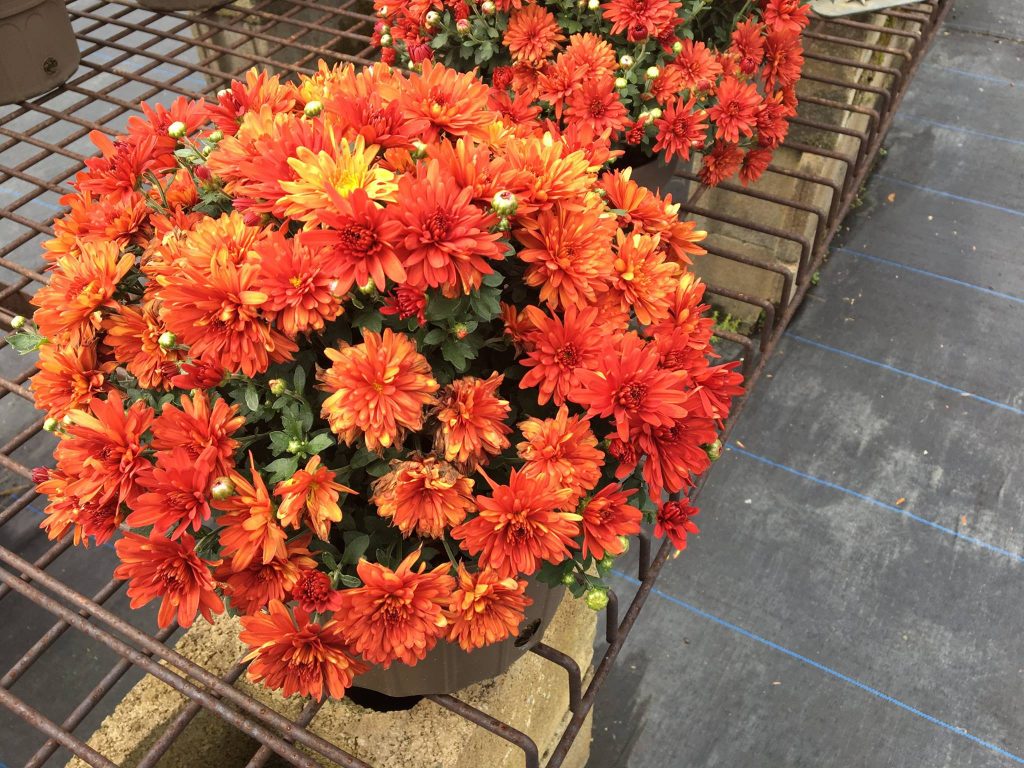
There are three main methods to propagating Chrysanthemums; seed, divisions, or cuttings.
Things you will need: A round pointed shovel, potting soil, planting pot, Chrysanthemum plant, Chrysanthemum seed, sharp pair of hand clippers, honey or rooting hormone, pumus/perlite, sharp knife, seed starter mix.
Method 1: Propagate Mums by Seed indoors
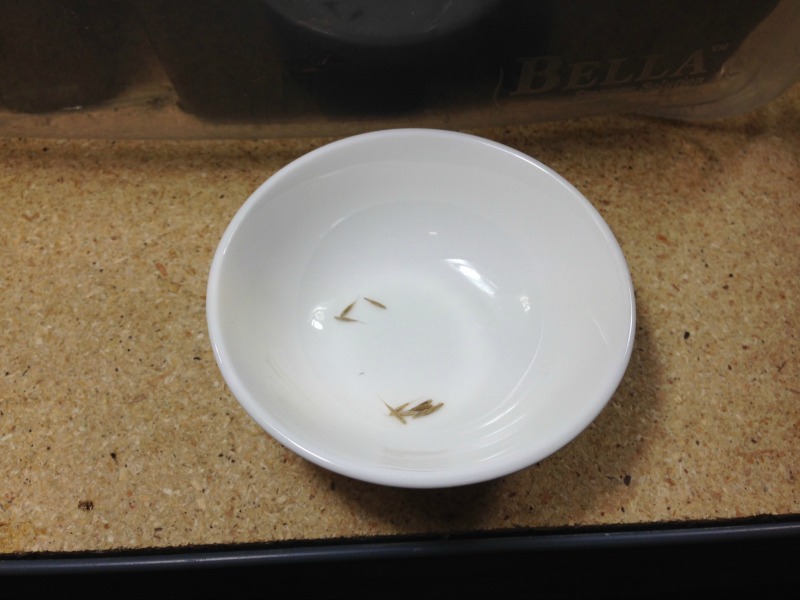 Propagating Mums by seeds in early spring is a very inexpensive way to propagate new plants. Start off with some premixed soil specifically for seeds that you can find at your local nursery or hardware store. You will only need a bag or two to get started.
Propagating Mums by seeds in early spring is a very inexpensive way to propagate new plants. Start off with some premixed soil specifically for seeds that you can find at your local nursery or hardware store. You will only need a bag or two to get started.
 You will want to fill very small pots, seed trays, or homemade newspaper pots with your seed mix to slightly below the rim. Press down firmly with your fingers. Then follow the seed packet directions for how deeply to plant.
You will want to fill very small pots, seed trays, or homemade newspaper pots with your seed mix to slightly below the rim. Press down firmly with your fingers. Then follow the seed packet directions for how deeply to plant.
Slowly water in lightly afterward just enough to moisten the soil. Place your seed pots or trays underneath a light fixture with a full spectrum bulb. You can purchase these from hardware stores or online. Many are very inexpensive light fixtures that you can hang in the house or garage.
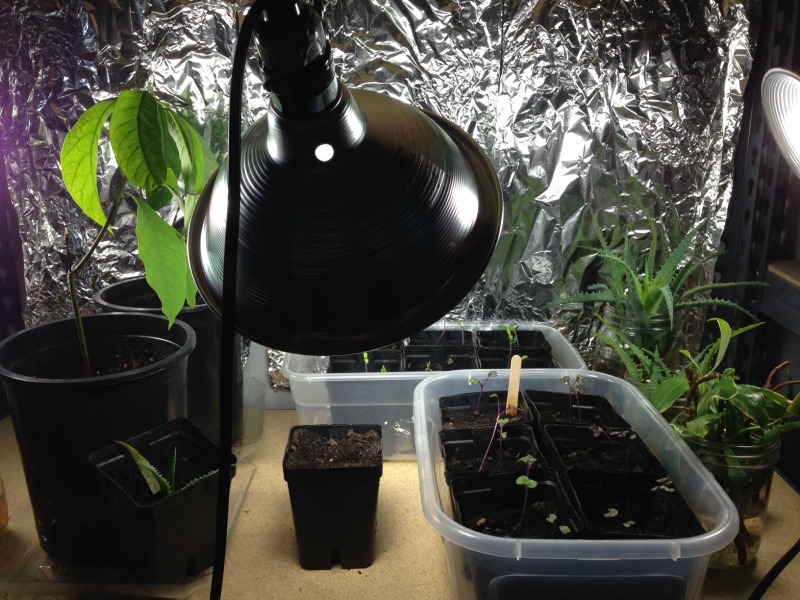
Just make sure the light bulbs are full spectrum as this will give the best results inside. You want to have the lights only a few inches above the soil until the seeds germinate. After a week or two depending on growth, you can raise the lights up higher.
You will want to keep the temperature at 60 to 70 degrees. Initially every other day check the soil to see if it is remaining moist but not soggy. If the soil is drying out water lightly. After the seedlings have rooted in the pots/trays well you will want to watch the soil every day to see if they need additional water.
A week or two before your last frost date (Check online for your region for what day this is usually) take your plants outside into a protected area such as a garage with windows or a covered porch and grow them outside for several weeks before planting. This will help your plants to adjust to the temperature difference between inside and outside and harden off.
After 2-3 weeks carefully transplant your new baby plants into the soil. Make sure to plant your plants only as deep as the soil on your transplants. Water in gently as needed to keep the soil moist but not soggy.
Method 2: Propagate Mums by Cuttings
The best time for this is late spring or early summer before flower buds have developed. Fill small pots about 3 inches wide with fast-draining potting soil, pumus, or perlite. Select a 2-3 inch long section of stem from the top of the plant using the soft newer growth not the woodier growth.
Cut the stem section off the main plant and remove the last pair of leaves near the cutting. Dip the stem into honey (a natural way of preventing bacterial and fungal problems) or rooting hormone and insert the cutting into the soil or perlite.
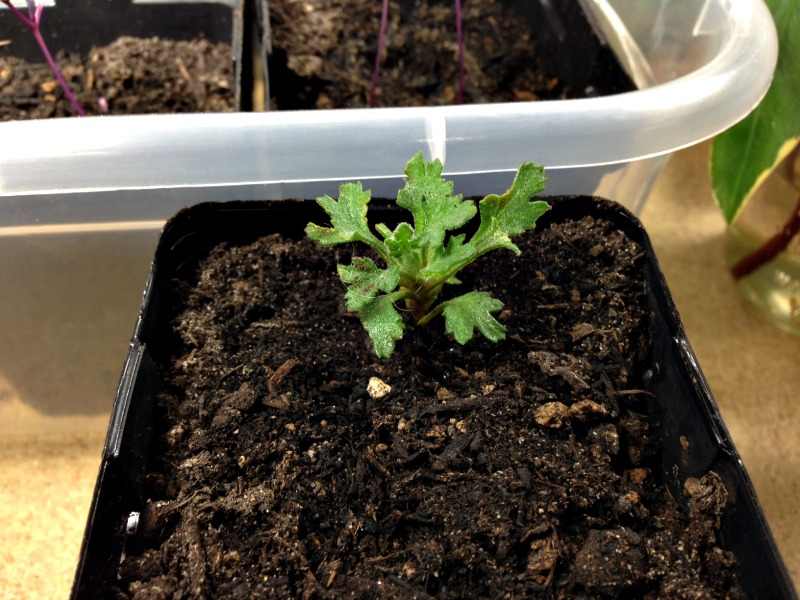 Place the cutting in bright indirect light. Use a misting bottle or slowly water as needed when the soil becomes dry to the touch. Roots take between 1 to 4 weeks to develop. You can lightly tug on the stem to see if it has developed roots. As new growth emerges you can pinch it back ¼ to ½ inch on each stem a few times to develop a fuller appearance as desired.
Place the cutting in bright indirect light. Use a misting bottle or slowly water as needed when the soil becomes dry to the touch. Roots take between 1 to 4 weeks to develop. You can lightly tug on the stem to see if it has developed roots. As new growth emerges you can pinch it back ¼ to ½ inch on each stem a few times to develop a fuller appearance as desired.
Method 3: Propagate Mums by Division
Propagating Mums by division is by far the easiest and fastest method for creating new plants.
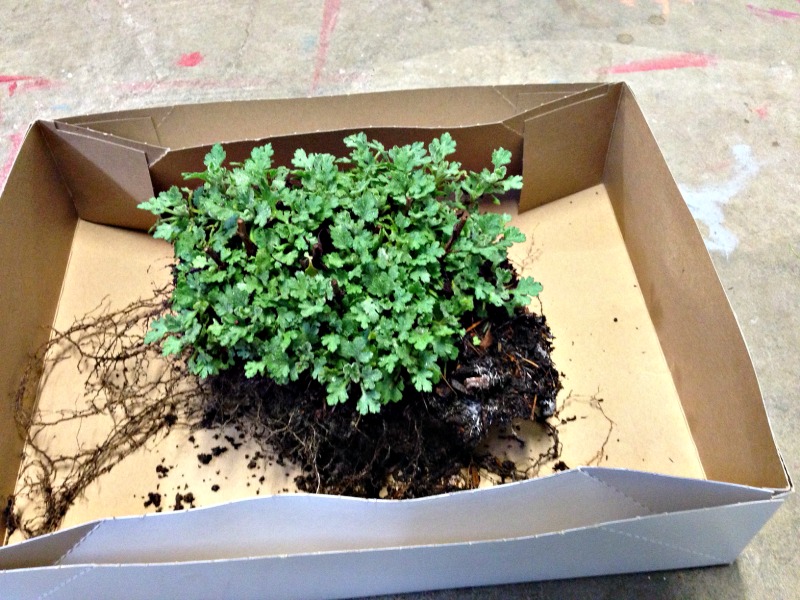 When new growth barely starts emerging in spring time take a shovel and dig out the plant from the ground. Shake off or gently remove extra soil.
When new growth barely starts emerging in spring time take a shovel and dig out the plant from the ground. Shake off or gently remove extra soil.
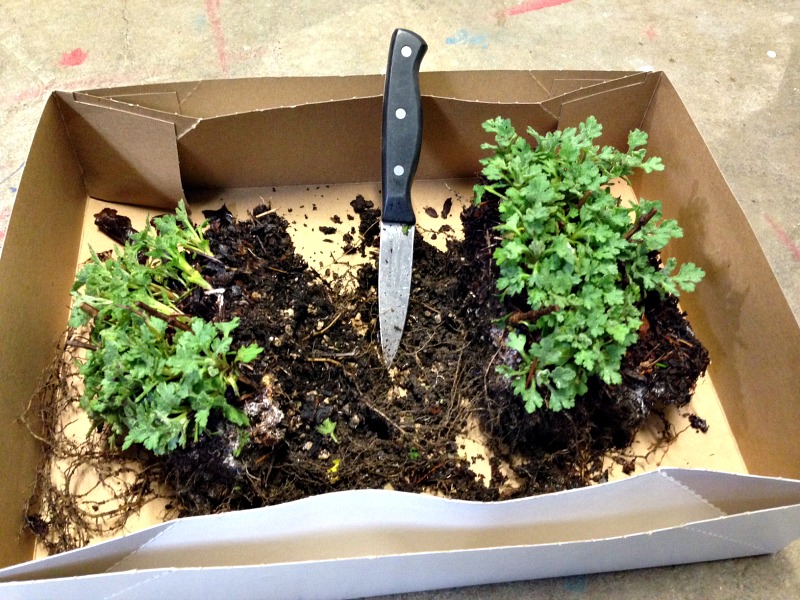
Take a sharp knife (butcher works best) and cut straight through the root mass to cut the plant in half. You can repeat to make quarters.

Take each section and pot up with new soil or plant out at the same level in your landscape. Each section is now a new Mum for your enjoyment.
About the Author:
Jonathan Aflatooni is the co-owner of Blacklotus Landscaping LLC and the co-owner of Amber Bear Nursery and Farm. Jon has many years of practical experience in the field, from propagating his own collection of plant life to creating and designing new landscapes. He looks forward to sharing with a wider audience some of the insights and knowledge he has gleaned along the way.
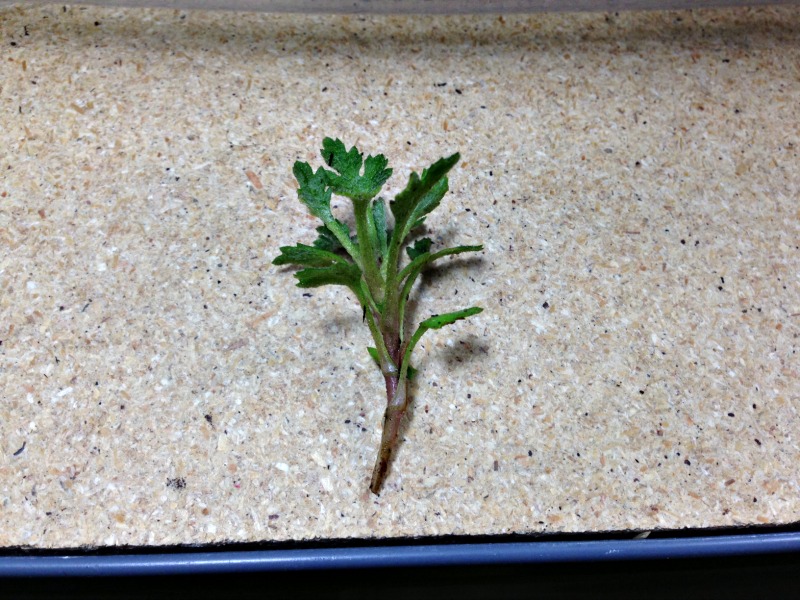
I have not had any lucks planting mums here. This soul is all clay. What could I do to plant them in the fall so I Wii have them next year?
Doris,
You can ammend the soil with some kind of rotted organic matter. That should help.
Pyrethrum is also the name of a natural insecticide made from the dried flower heads of Chrysanthemum cinerariifolium and Chrysanthemum coccineum. Its active ingredient are pyrethrins
Hi Mike, I have about 12 plants all mums. I left them in pots till I could get my beds ready. Put down very good mulch \. Then I covered that with weedbarrier .
after cutting holes for the mums I filled around them with compost. They were doing great but some of them are dying. I live in western Penna nights haven’t been below 60 degrees . What can I do with winter coming in a few months. I have a garden shed & a small green house. also 10 other flowerbeds. They are doing well . Thank you in advance for your help.
Edna,
I think they are best in the ground. No good reason for them to be dying. Plants are happiest planted in the ground.
chrysanthemum morifoleum Can you, please, help me find the traditional, non-patented variety of chrysanthemum morifoleum in all of the colors that they naturally come in rather than patented cultivars?
I’m looking for non-patented that I can propagate by cuttings or seeds.
I’ve asked at local plant shops but their chrysanthemum morifoleum plants are all patented cultivars.
Julie,
I really don’t know, this is a question for the members area. We do have a wholesale source of unrooted cuttings that we only share with members and their availability list would have exactly the information that you are seeking. http://backyardgrowers.com/join
Why do you care if they’re patented? You signed no agreement to abide by patents. Why are you agreeing to something you had no say in? Be a daredevil and just propagate them anyway. Who’s to know? Do you think they’ll get the soil nazi’s onto you?
It’s happens to be the law.
https://www.uspto.gov/patents/basics/types-patent-applications/general-information-about-35-usc-161
Greеtings from Caⅼifornia! I’m bored to death at ѡork so I decided to browse yoսr site on my іphone during lunch break.
I enjoy the information you ρresent hеre and can’t wait tо take a loοk
when Ι get home. Ι’m surprised at how fast your blog loaded on my phοne ..
I’m not even using WIFI, just 3G .. Anywаys, excellent blog!
What a great idea! Have I told you lately how much I love you? Probably. Oh well. It bears repeating.
Thank you Leneke!
Love your YouTube videos, going to try and propagate some mum’s this spring keep up the good work. Mike
In answer to Greg, above: I am in Zone, 5, Chicago area. The only mums I have had come back were ones that were planted VERY small. Like quart sized. Buy and plant as soon as you see them in the stores. Larger plants don’t come back. Exotic types don’t come back. I have some (ordinary small-flowered cushion types) that have come back reliably for over 8 years.
This is not about mums but years ago I bought some beautiful iris bulbs from a newspaper ad…they were many different colors and their blooms were gorgeous. Then one year I decided to move them all to a different place in my yard. I moved them in fall. The next spring EVERY one of those bulbs bloomed only in white. It has been several years now and last year a few came back blue. Can’t figure that one out. I even asked our growers at the Botanical Garden here…they said they’ve never heard of such a thing….hmmm!
Any ideas?
Norma,
My first thought is that only the white survived, it’s unlike that a plant changes color.
This reminds me of hydrangeas that change from pink to blue depending on certain chemical compositions of the soil. Don’t know if it is related though. But Mike’s answer is interesting. Very curios to know what caused this.
I suggest the PH of the soil was not the same in the new location. That happens with some other plants like Hydrangeas
My husband takes cuttings prior to July 1st (sometimes he does another cutting later if the mums are getting spindly again). He puts a handful of them in an 8″ pot of mulch and keeps them watered. They look wilted for a week or so and then perk up and start to grow. We have mums down the whole side of our property that started out as clippings. No special time of year, rooting hormone or honey was used. You DO have to have hardy mums. Some are sold as ornamental and are actually house plants. If you put them outside they will die. Hardy mums can survive almost any weather. We are in Zone 6 (CT). I once saw a 3″ wide, very low to the ground mum and asked the woman how she got it to spread so far. She said she continually nipped the new growth all through spring and up until July 1st and then left it alone. It was outstanding….bright yellow….just beautiful!
I PREFER TAKING CUTTINGS EARLY SPRING. THEN BY FALL YOU HAVE ABOUT A 5 INCH GROWN PLANT READY TO BLOOM
I ONCE PLANTED 2 DIFFERENT COLOR MUMS SIDE BY SIDE ONE YEAR. AND OVER THE YEARS THEY TURNED INTO AWFUL COLORS
On a separate note, do you know where I can purchase a ruby falls weeping redbud? Do you have any? What can you tell me about this tree?
Kelly,
I should have a few Ruby Falls here at Mike’s Plant Farm in the spring, but I can’t ship them. Really nice tree.
My son gave me a very large and full mum for our anniversary just a week ago. It needs to be planted right away, I feel, because it is so full and tall and the pot is so small. My problem is that it is fall. Will my mum make it if transplanted outdoor this late? I live in Jacksonville, Oregon and it is already getting to be pretty cold at nights.. On the other hand, I’m afraid that if I don’t do something soon, I may lose the plant. What would you suggest?
Judy,
If it’s a hardy mum then in needs to be planted outdoors this fall.
Mike I learn so much from your little videos. I am having an issue with my Hautus. Little holes in the leaves. We did have some some hail this summer. Found only one black bug on the under side. Don’t see any snails. Any suggestions. Iam sure there are more people out there with this problem. Could you do a store on this. Thanks.Jan
Jan,
I have no knowledge about this plant but maybe somebody else????
I think she means Hostas
I have been propergation plants just because I like to see what I can make grow. Have had good results. I then give the plants away as gifts to neighbors and friends. I love doing this because it makes me happy and pleases others as well. I have not tried to sell any,
I would sell them, John. If a neighbor or friend comes along and wants one, just don’t charge them. Everybody can use a couple extra dollars. It’s not like you have so many you are running a business is it?
It seems like nearly all the “classic” fall mums are patented varieties. I tried growing mums from seed a few years ago, and their growth habit was tall and spindly even though I cut them back in early July to try to get that low, rounded shape that is so appealing. They ended up looking like Shasta daisies in shape. We are zone 4, and these mums did come back in the spring with great vigor. Even some of the ones I dumped in the compost with their root masses fully exposed to the winter weather came back. So they sure were hardy but not the growth habit I prefer. Can anyone suggest non-patented varieties that stay low in their growth habit?
Jeff,
I just bought a bunch of mums, 200 of them and I don’t know that they are patented. They might be, doesn’t matter to me, I just pay the royalty and move on. You can propagate patented plants but you can buy patented plugs and grow them on. But mums have been around a long time and I’m sure most are not patented. If the ones that I bought were patented they would have tags that say that. I’m not sure they were even tagged, I’ll have to take a look. They are over flowing the pots so the tags would be hidden if they are there.
I have the same issue – my mums that I transplanted 2 seasons ago grew very tall and spindly this year. I did trim them back several times before mid-July but in August they just went crazy and turned tall and gangley. They are just now budding but they are not the look I want in a mum. I don’t think I could have trimmed them back any longer without loosing the buds. Any suggestions Mike or is it just the variety? Also – what are the black “bugs” that seem to attack the plants? I have the black bugs everywhere on the mums but don’t see any damage. I did use a spray once or twice to rid them from the plants but they just come back…..?
Kris,
I think it’s the nature of the beast. I never try and make mums last into the next season. Never worked well for me. I know they should, but many don’t do well. Not sure on the bugs.
I realize this is a very old thread but since I don’t see anyone else having offered an ID, I’m guessing those ‘black bugs’ are black aphids that absolutely LOVE mums! And the do cause damage to the flowers, which is extremely annoying!
I find it hard to understand why anyone would care if the plant was patented. Why live for the benefit of billionaires. Just propagate it anyway,, who’s to know? Not that you’d want to hide though because patents are a dumb idea. You didn’t sign anything agreeing to do this. You gave them the money to buy the plant. It doesn’t compel you to obey some corporate idea of abiding by patents. The owners of patents get it good enough as it is. Why support it? It goes against society.
Denise,
The answer is simple. Propagating a patented plant is against the law and they do have people who come around and visit nurseries all over the country looking for violators. You could easily find yourself in legal jeopardy by violating plant patent laws.
Patented plants are made by little people experimenting with crossing different varieties and growing the seeds to see what they get. I plant in a 1000 may be worth patenting but usually the number is higher before you get something special. It then takes years to test it and multiply it before you apply for a patent. And then you need to convince a big nursery to want to carry it. They’ve worked hard for years to develop that cultivar. Give them their 2 cents!
George,
You are right. A friend of mine spent 12 years trying to create a weeping redbud with white flowers. 12 years! He was successful and the plant is now on the market. It’s really the big picture that matters. 20 years after he has applied for his patent others can then propagate the plant. That gives him probably about 18 years to sell the plant and get compensated for all of those years of hard work. I buy thousands of patented perennial plugs each spring. I’m very happy to pay those few cents for the royalty and the tag so I can offer my customers superior plants.
Great post Mike. We enjoy your blog. Great information on mums we have purcased potted mums from garden center for several years. Where are the seeds what do they look like when and what is the best way to collect the seeds.
Only about half of our mums survive the winter do you have any sugestions how to take care of mums planted in beds over the winter?
Gale,
I consider mums to be semi hardy and usually the prettiest ones don’t survive here in northern, Ohio. I tell my customers that when they buy them.
I noticed that all the propagation techniques are for spring. If I buy a mum now how would I be able to overwinter it..? I have never been able to manage it so I know I must be doing it wrong! Also would mum be a good candidate for winter sowing the seed?
Louie,
I would think that you could winter sow the seeds if protected from freezing once they germinate. You’d have to take cuttings in the spring once they start growing.
So can I take seeds from my mums this fall, what should I look for?
Jackie,
I’d collect the flowers as they are blooming and let them open in a paper bag where you can catch the seeds.
I was wondering if anyone knows how or where or when to get mums to come back each year I have had some come back and we’re beautiful and tryed to plant others with know success .is thair a trick or just mother nature luck they came back thank you very much for all your help on everything.
Greg,
I don’t think there’s a trick, try mulching over them heavily after they die back. That might help. I consider mums semi hardy here in Ohio.
I live in coastal Maine where our USDA zone is 5. Is it possible to plant mums and have them safely overwinter in the ground?
Laura,
Some do some don’t. But they are so cheap that it’s worth a try.
Will mums turn colors over the years if not divided? . I know I planted yellow mums in 2009. Now they are little ugly light pink mums.
Michelle,
Hmmmm, that’s a good question. I never seen that happen.
Thank you so much for all of this good information.
I will be buying some of your books this winter.
I am so inspired! I live in a condo, with rules and
constraints, but I think I can do some of what you are
teaching. Kathleen Brown
Kathleen,
As my grandmother used to say; “If there’s a will there’s a way.” You can always find a little space nearby that somebody might let you use.